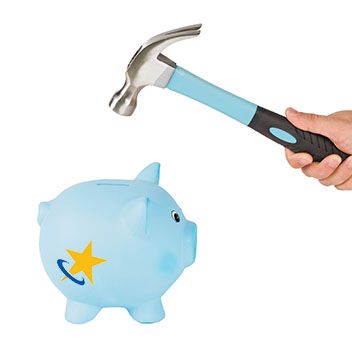Ever wonder why getting a credit card is difficult when you turn 18? A major reason is the Credit Card Accountability Responsibility and Disclosure Act of 2009 (CARD Act). This law requires you to be at least 21 to open a credit card without a cosigner — unless you have proof you can repay the debt on your own. It also prevents credit card companies from sending you unsolicited pre-screened offers before the age of 21.
These measures have made it harder for young adults to get credit cards over the last 15 years. However, a new type of credit — the Buy Now, Pay Later (BNPL) loan — has emerged without such restrictions and it has skyrocketed in popularity. This trend begs the question: Are BNPL loans filling the gap left by credit card protections? And, more importantly, should you be wary of getting one? Here’s what you need to know.
The Problem with Credit Cards for Young Adults
Turning 18 marks the beginning of adulthood and newfound independence. But the first few years can be hard as the cost of living is high, entry-level wages are low, and developing financial savviness takes time. Plus, if you're in college, you have added expenses and limited time available for work.
In times like these, credit can seem like a lifeline. When ends don’t quite meet, you can charge expenses and plan to pay them off later. But the problem is — if you’re already struggling financially, paying off your credit card and keeping up with all your expenses is likely going to be difficult.
Unfortunately, falling behind can quickly spiral into mounting debt, growing interest, and credit score damage.
Quick facts on young adults and credit card use:
- 84% of 22-24-year-olds had a credit card in 2023. (Transunion)
- 22-24-year-olds with credit cards had an average balance of $2,834 in 2023. (Transunion)
- Increases of $1,000 in student loan and credit card debt resulted in 6% and 4% higher odds of distress, respectively. The comparison showed credit card debt inflicted twice as much stress. (APA PsycNet)
Credit Cards vs. BNPL Loans
The use of BNPL loans has surged over the past few years — growing from 16.8 million loans issued in 2019 to 180 million by 2021. But how do they compare to credit cards? Here’s a closer look at how each works.
Credit Cards
Credit cards provide a revolving credit line you can use, repay, and use again for as long as you keep the account open. If you use the credit card and pay off the balance in full by your payment due date, you won’t be charged any interest.
However, if you carry a balance beyond the grace period, interest charges accrue until the balance is paid off. For reference, the average interest rate on credit cards is currently 21.47%, according to the latest data from the Federal Reserve.
Credit card companies only require you to make a small minimum payment each month, which makes it easy to carry credit card balances and rack up interest charges. Some also charge fees, such as those for annual membership, late payments, cash advances, and returned payments.
As for applying, you’re required to undergo a hard credit check to get approved, and the eligibility requirements tend to be moderately strict. Once you have an account, card providers report your account activity to the consumer credit bureaus each month.
BNPL Loans
BNPL loans are installment loans for retail purchases, meaning you borrow a lump sum for a purchase and pay it back through fixed payments over a set term.
You may see the option for a BNPL loan when you’re checking out with a merchant online. But you can also download the app of a BNPL provider like Affirm to see the loan amounts available to you with a pool of retailers.
BNPL lenders often offer short, interest-free loan options, such as four biweekly payments over six weeks. Additionally, many offer longer-term plans with lower monthly payment amounts that come with interest charges. For reference, APRs often range up to 36%.
Unlike credit cards, applying for a BNPL loan doesn't usually require a hard credit check. Further, providers are typically more lenient with their eligibility requirements and don’t always report the accounts to the credit bureaus.
| BNPL Loans | Credit Cards | |
|---|---|---|
| Credit Type | Installment loan | Revolving credit line |
| Access Point | Checkout with merchants or a BNPL app | Physical card |
| Interest-Free Credit | Yes, for short term loans | Yes, if you pay off balances in full before the due date |
| Interest Rates | 0-36% | 21.47% Average |
| Fees | Depends; possibly late fees | Late fees, cash advance fees, and sometimes annual fees |
| Eligibility Requirements | Lenient | Moderately strict |
| Hard Credit Check | No | Yes |
| Reports to Credit Bureaus | Sometimes | Yes |
| Minimum Age | 18 | 18, but must have a cosigner or proof you can afford the debt independently under 21 |
BNPL Pros and Cons for Young Adults
The convenience of BNPL loans is hard to beat as they’re often built into the checkout process and don’t require a hard credit inquiry. Plus, the lenders tend to have very lenient eligibility requirements, meaning you may get approved despite getting denied for other traditional credit products. Within a few seconds of applying, you can feel a sense of relief knowing you don’t have to pay the full amount for a purchase on the spot.
But is that generally a good thing?
An October 2023 New York Fed survey found that borrowers who are considered financially fragile are almost three times more likely to have repeated BNPL use (five or more times) than financially stable consumers. Additionally, researchers at Harvard Business School found that BNPL use has been associated with an extended increase in total spending and a higher likelihood of incurring late fees and dipping into savings.
These trends are concerning because, similar to credit cards, BNPL loans seem to be overextending vulnerable borrowers.
The Verdict: Are BNPL Loans Worse for Young Adults Than Credit Cards?
While both BNPL loans and credit cards can lead to financial strain for vulnerable young adults, BNPL loans currently present more risk. BNPL lenders have lenient eligibility criteria and don’t always report the loans to the consumer reporting companies, which allows young borrowers to quickly rack up multiple BNPL loans without fully realizing their long-term impact.
So, what protections are in place? The Consumer Financial Protection Bureau (CFPB) issued an interpretive rule in May of 2024 stating that BNPL lenders are considered credit card providers and must provide some of the key legal protections and rights that apply to conventional credit cards. However, the intention to revoke that rule was announced in March of this year, so the future of BNPL regulation is uncertain. Beyond that, consumer reporting companies are planning to generate alternative BNPL credit scores, which will be included on credit reports and available for request by lenders.
In the meantime, it’s important to be mindful of your spending, no matter what new credit product may hit the market. A good place to start is making a budget and identifying the goals you’d like to achieve in the upcoming year and beyond. When you have a plan for the financial future you want, it makes it easier to resist impulse purchases. Building savings is also important, so you don’t have to borrow for splurges or emergencies. Even setting aside a small amount each paycheck will make a difference over time.
The bottom line: Credit can be a useful tool, but the key is using it strategically to your advantage, not relying on it to make ends meet or live beyond your means.







